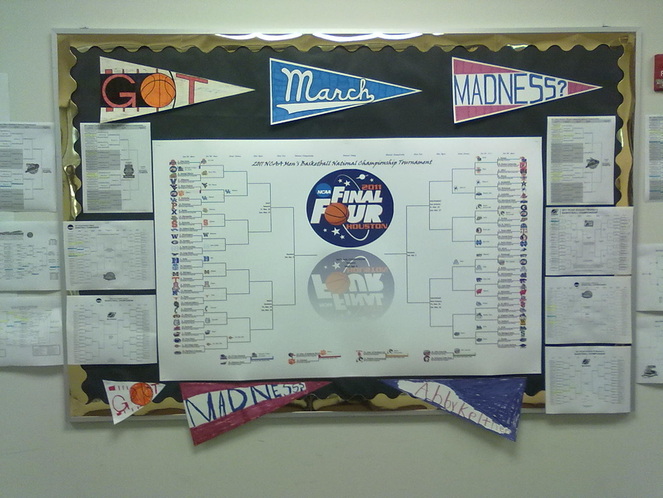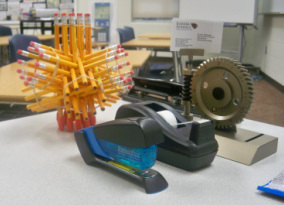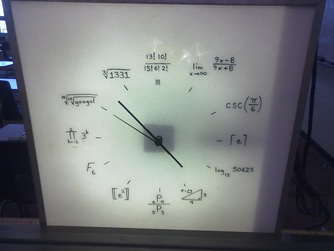
I'm going to include more details on how I pulled off this display once my daughters go to sleep. Could be around Thanksgiving, at the rate they're going.
|
 Originally, I began constructing my own NCAA brackets because I disliked the gratuitous advertising that took place on the copies available through different media outlets, as well as the NCAA itself. So, while I'm probably violating just a smidge of copyright infractions by using their logos, I'm not promoting gambling in my classes by "making predictions" about games' outcomes, nor am I promoting the latest multi-million dollar movie Michael Bay is releasing as a result of the ad banner appearing on a network's copy of the bracket.
I'm going to include more details on how I pulled off this display once my daughters go to sleep. Could be around Thanksgiving, at the rate they're going.
1 Comment
 Back-to-school sales are fun. Last year, I picked up FAR too many pencils to be used in a school year because of their low, low prices. I have been following George Hart's creations for a while and am excited for the opening of the Museum of Mathematics later this year. This particular construction was based on Hart's work entitled "72 Pencils." Thanks to friend Pat Flynn for use of his photo at left. As part of a visual example involving recursive functions (showing how one thing relies on another previous value), I created several cousins of Hart's design, using some accumulated pencils I had in my classroom from over-anticipating students needing to borrow them. They are shown in this short YouTube video I created: Obviously, my construction are held together with rubber bands. The disclaimer I would place on this project is that--to avoid bands snapping and the ensuing pencil grenade that would scatter itself about your space--you inspect your bands from time to time. Put on a new band and remove the old, as needed.
As far as difficulty in completing this project, I would emphasize this project requires patience more than it requires skill. Band together enough pencils to satisfy one "axis" of the construction and begin creating another "axis" by inserting pencils through it, intersecting with the appropriate number of pencils between opposing axes. Good luck. Please comment and let me know what you think. --Keltner--  In my younger days, I had a summer job at a heating/air-conditioning/plumbing/electric/lumberyard/hardware store [link to their Facebook page] and learned a lot of trades (I think my forklift operator's license is still valid, come to think of it). One physical thing I came away with was the frame for this clock, which the owners let me have since it was an OLD light advertisement for GE Light Bulbs that they had picked up at an estate sale many years prior.
Years later, I scored a summer job with a sign company (using my forklift operating prowess to become a crane operator) and learned a few tricks of that trade that helped in creating numerous displays and handouts for my classes. I used a plexiglass surface to allow expressions to be changed, depending on the unit your class is covering. Here's the shopping list of things I used for this project:
That's it! Inexpensive, super fun to put together. It is amazing the amount of foot traffic that finds its way past my classroom now so students can explain to one another why a particular expression is in place of a certain hour. Call it reverse engineering, of sorts, since they already know the answer but need to figure out how we get there. I hope you enjoy this project as much as I did. Let me know in the comments. --Keltner-- My daughter recently complete first grade, a proud moment no doubt. Towards the end of the school year, she brought home her list of spelling words for the week, one of which was "multiply." To properly learn to spell the word, she asks what it means and tries to use the word in a sentence throughout the week. Handing the list of new spelling words over to her mother, she quickly asked "Mom, what does 'multiply' mean?" After the echoes of her mother's groans subsided, she managed to say "Oh, go ask your father." I'm not saying this was my culminating moment as a father, but knew the pressure was on nonetheless. I opted for the quick, easy response (I was happy she was doing her addition and subtraction facts better than some of my high school students, so thought multiplication facts could wait for a while longer), summarized in the dialog below: Daughter: "Dad, what does 'multiply' mean? It's one of my spelling words this week." Me: "It's the 'x' button on your calculator." [Author's note: Yes, she does have her own calculator as a 1st grader. She calls it a 'clack-a-mo-later.'] D: [runs to her room, grabs calculator, enters 2 x 2 and sees the result 4] "So, 2 multiply 2 makes 4. So 'multiply' is just a fancy word for 'add' then?" Me: "Not quite. Let's try another one, like 3 x 3. What's your clack-a-mo-later say now?" D: "9. So did it just do the 6 upside down for adding this time?" [Good observation, and on the right track, but no dice yet.] Me: "Well, hold up three fingers on each of your hands. How many times do you see three?" D: "I see it two times. So is that 3 TIMES 2?" Me: "Yeah! So what needs to happen for 3 times 3?" D: "You need to hold up three fingers on one of your hands, right?" Me: "Okay, but see if it agrees with the 9 your clack-a-mo-later said." D: [mouthing '3 plus 3 plus 3...equals 9'] "Its NINE, Dad!" With as much enthusiasm as she's followed up this discovery with, I'm waiting for some of my students to take her along with them so they can ask multiplication facts when the need arises. Either that, or they'll keep her handy with her trusty clack-o-mo-later. Actually, here's a few photos of her "Multiply Book" she assembled the days following this newfound fascination with numbers:  Essentially a stack of Post-It Notes, she crafted her own set of multiplication flash cards.
At least she's accurate. --Keltner--  As a math teacher, I am compelled to emphasize the importance of the coordinate plane on a regular basis. I have introduced the concept, terminology, and applications regularly but just in the past few years emphasized the historical context that brought about recognition of the Cartesian plane.
Of course, I'm referring to Rene Descartes and the "fly on the wall" story by which he developed the ideas behind the coordinate plane we use today. While the true history of this topic is not the most enthralling, with a little bit of indulgence on the part of the storyteller (me), it comes to life and is relevant to my students. Examples of how I've indulged this story:
So, with that, I introduce to you my "Good For Nothing" website. Thanks for your support. --Keltner-- |